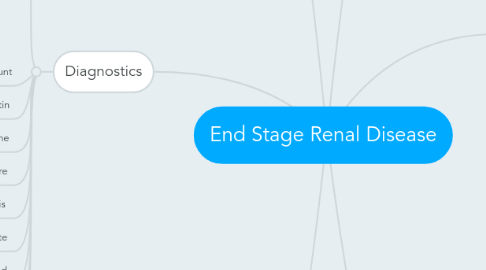
1. Pathophysiology
1.1. nephron destruction
1.1.1. compensatory mechanisms
1.1.1.1. hypertrophy
1.1.1.2. hyperfunction
1.1.1.2.1. filtration
1.1.1.2.2. reabsorption
1.1.1.2.3. secretion
1.1.1.3. temporary maintenance of normal clearance rate of waste products
1.1.1.4. damage to glomerular capillaries
1.1.1.4.1. focal and segmental glomerulosclerosis
1.1.2. progressive renal injury
1.1.2.1. systemic hypertension
1.1.2.2. nephrotoxic medications
1.1.2.3. decreased renal perfusion
1.1.2.4. proteinuria
1.1.2.4.1. contributes to tubuloinsterstitial injury
1.1.2.5. hyperlipidemia
1.1.2.6. hyperphosphatemia
1.1.2.7. angiotensin II
1.2. decreasing renal mass with age
1.3. eGFR and level of proteinuria predict outcome of ESRD
2. Diagnostics
2.1. blood chemistry profile
2.1.1. potassium
2.1.2. sodium
2.1.3. albumin
2.1.4. blood urea nitrogen
2.1.5. phosphorous
2.1.6. calcium
2.1.7. magnesium
2.1.8. creatinine
2.2. complete blood cell count
2.3. erythropoetin
2.4. parathyroid hormone
2.5. blood pressure
2.6. urinalysis
2.7. eGlomerular Filtration Rate
2.8. renal ultrasound
2.9. CT Scan
2.10. Kidney biopsy
3. Clinical Manifestations
3.1. common symptoms
3.1.1. fatigue
3.1.2. pruritis/dry skin
3.1.3. headaches
3.1.4. nausea
3.1.5. loss of appetite
3.1.6. weight loss without trying
3.2. other symptoms
3.2.1. abnormal skin coloration
3.2.2. nail changes
3.2.3. bone pain
3.2.4. confusion/ altered mental status
3.2.5. numbness in extremities
3.2.6. muscle twitching/cramps
3.2.7. easy bruising/bleeding
3.2.8. breath odor
3.2.9. amennorrhea
3.2.10. vomiting
3.2.11. excessive thirst
3.2.12. peripheral edema
3.2.13. decreased urine production
3.3. less than 10% kidney function remaining
4. Risk Factors
4.1. chronic kidney disease
4.1.1. progression of disease
4.1.2. APOL1 gene
4.1.3. FGF-23 gene
4.1.4. SNP's
4.2. other diseases
4.2.1. rhabdomyolysis
4.2.2. high blood pressure
4.2.3. diabetes
4.2.3.1. largest single cause of ERSD
4.2.4. lupus
4.2.5. urinary tract obstruction
4.2.6. glomerulonephritis
4.2.7. nephrotic syndrome
4.2.8. cystinosis
4.3. infection
4.3.1. E. coli.
4.3.1.1. hemolytic uremic syndrome
4.3.2. pyelonephritis
4.4. congenital diseases
4.4.1. Alport syndrome
4.4.2. polycystic kidney disease
4.5. injury/trauma
4.5.1. major blood loss
4.5.2. myocardial infarction
4.6. medication
4.6.1. nephrotoxicity
4.6.2. reaction
4.7. tobacco use
4.8. obesity/high BMI
5. Incidence/Prevalence
5.1. 116,946 patients US in the began dialysis for ERSD in 2010
5.1.1. this was the first decline in numbers for 3 decades
5.2. blacks are 3.8 times more likely to have ESRD than whites
5.3. Highest rates of ESRD are in Ohio Valley, Tx, CA, and south western states
5.4. greatest percentage and greatest growth in cases of ERSD in population 75 years and older
6. Treatments
6.1. dialysis
6.1.1. removes sodium and waste products
6.1.1.1. helps lower blood pressure
6.1.1.2. only removes 15% of waste products
6.1.2. maintains proper vitamin/mineral balance within body
6.1.3. stimulates red blood cell production
6.1.4. used when kidney function is down to 10-15%
6.1.5. two types of dialysis
6.1.5.1. hemodialysis
6.1.5.2. peritoneal dialysis
6.1.5.2.1. continuous ambulatory peritoneal dialysis
6.1.5.2.2. continuous cyclic peritoneal dialysis
6.1.5.2.3. intermittent peritoneal dialysys
6.2. kidney transplant
6.2.1. must qualify for transplant
6.2.1.1. no psychiatric illness
6.2.1.2. no incurable heart disease
6.2.1.3. no recent cancer
6.2.1.4. current life expectancy >5 years
6.2.1.5. active substance abuse
6.2.2. matching
6.2.2.1. blood type
6.2.2.2. cross-match
6.2.2.3. HLA
6.2.2.3.1. 6 antigen match is 1 in 100,000
6.3. dietary modifications
6.3.1. low protein
6.3.2. high calorie
6.3.3. limit salt, potassium, phosphorus
6.4. medications/supplements
6.4.1. phosphate binders
6.4.2. calcium + vitamin D
6.4.3. H2 blockers
6.4.4. blood pressure medications
6.5. treatments for anemia
6.5.1. erythropoetin
6.5.2. blood transfusion
6.5.3. iron supplements (oral, injectable)
